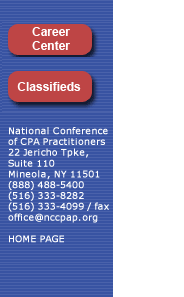

| |
|
|
|
|
|
|
|
|
|
|
|
|
|

June 2005
MEMBERS’ CORNER
BY STANLEY TEPPER, CPA, MBA
Personal Exemption – No personal exemption will be allowed to an individual eligible to be claimed as a dependent on another taxpayer’s return.
Grantors of Options – If you write an option through the exchange, you do not treat the premium received for writing the option as income at the time of receipt. You do not realize profit or loss until the option transaction is closed. This may occur when the option expires or is exercised or when you “buy in” on the exchange an option similar to the one you gave to end your obligation to deliver the stock. Here are the rules for these events:
- If the option is not exercised, you report the premium as short-term capital gain in the year the option expires.
- If the option is exercised, you add the premium to the sales proceeds of the stock to determine gain or loss on the sale of the stock. Gain or loss is short term or long term depending upon the holding period of the stock. (J.K. Lasser’s Your Income Tax – 2005.
IRA Deduction – You can file your tax return claiming a traditional IRA Deduction before the contribution is actually made. However, the contribution must be made by the due date of your return, not including extensions.
Retirement & Pension Plans – Employer contributions to individual retirement accounts under Simplified Employee Pension Plan (SEP) – exempt for social security, Medicare and federal unemployment, except for amounts contributed under a salary reduction SEP agreement. Roth IRA – With a Roth IRA, you contribute after tax dollars, but future withdrawals come out tax-free. “I like to use the Farmer Analogy,” says Ed Slott, a member of our chapter and editor of Ed Slott’s IRA Advisor Newsletter. “With the Roth, you pay a tax on the seed, but the crop grows for free. With a traditional IRA, it’s the other way around.” (Business Week).
Documentation is Key in Discharging Disabled Worker – When can an employer lawfully discharge for poor performance an employee whom it perceives as having a disability? The 2d Circuit U.S. Court of Appeals dealt with this issue in Peters v. Baldwin Union Free School District. The Situation The plaintiff was a full-time high-school guidance counselor. The administration gave her professional performance the highest rating available, and the principal recommended granting tenure. The plaintiff’s supervisors were aware of her history of serious medical problems, including a facial tumor and neurological impairments. According to the plaintiff, the principal and assistant principal stated on several occasions that she wasn’t adequately caring for herself. When the plaintiff mentioned some pain she had experienced, she joked to a fellow guidance counselor that she could commit suicide with her police-officer husband’s gun. Both women later described the conversation as entirely in jest. But when the other counselor mentioned the conversation to the school psychologist, he became alarmed and reported the plaintiff was considering suicide. The superintendent and the principal reassigned the plaintiff to administrative duties and, at their request, she saw a psychiatrist who wrote a note clearing her to return to work. But the principal instead sent her to two more doctors, both of whom reported that she was fit to resume her regular counseling duties. At the principal’s direction, a guidance intern who filled in for the plaintiff prepared a list of problems she found with the plaintiff’s caseload. Because of these shortcomings, the superintendent denied tenure, citing the plaintiff’s “failure to complete assigned task” and “serious performance errors.” Then he discharged her because she had been denied tenure. The plaintiff sued the high school, the superintendent and the principal in federal court. Her complaint alleged that discharging her because they perceived her to have a disability violated the:
- Federal Rehabilitation Act (which applies to governmental entities that receive federal aid and is similar to Title VII), and
- New York State Human Rights Law.
She also sued the principal for defamation. The federal trial court handed down a directed verdict in favor of the defendants on all claims and she appealed. The Rehabilitation Act Because sufficient evidence existed to permit a rational juror to find in the guidance counselor’s favor, the 2d Circuit overturned the directed verdict on all claims except the defamation claim. The 2d Circuit found that the Rehabilitation Act bars excluding an otherwise qualified person with a disability, “solely by reason of his or her disability,” from participating in, or benefiting from, or being discriminated against under “any program or activity receiving federal financial assistance.” The act protects not only those who suffer from a disability, but also those whose employers perceive them as suffering from a disability –even if the perception is incorrect. The 2d Circuit held that the plaintiff’s evidence adequately showed that her employer perceived her as suffering from a mental illness that made her suicidal and in imminent danger of taking her life with her husband’s revolver. To determine whether her employer’s alleged perception brought the plaintiff under the protection of the Rehabilitation Act, the 2d Circuit had to determine whether her perceived condition was an “impairment” and whether it would “substantially limit” a major life activity. The court found she had present sufficient evidence of impairment – one relating to her ability to care for herself. Because the Rehabilitation Act recognizes the ability to care for oneself as a major life activity, it constitutes a protected disability. So the school district’s about-face on her performance could constitute sufficient evidence of improper motive. The Human Rights Law and Defamation Claim The 2d Circuit also set aside the trial court’s dismissal of the New York Human Rights Law claim. The 2d Circuit found that this act grants broader protection to disabled persons than the Rehabilitation Act, because plaintiffs needn’t show that a perceived disability substantially limits a major life activity. Finally, the 2d Circuit upheld the directed verdict on the defamation claim arising from the principal’s alleged false disparagement. The elements of a defamation claim are “a false statement, published without privilege or authorization to a third party, constituting fault and must either cause special harm or constitute defamation per se.” Investigate, Document and Watch What You Say The lesson for employers here is not to jump to conclusions. Had the school district thoroughly investigated, it would have learned that the suicidal comment was a joke. An ancillary lesson is that an employer dissatisfied with a worker’s performance should document the performance, as it occurs, not after deciding to fire the worker. Employers should follow normal procedures in documenting performance problems and not conduct a special review when a worker may have a disability . The defamation claim also serves as a good reminder for employers to be careful what they say about employees. (Taken from Franklin, Gringer & Cohen, P.C. Newsletter, (516) 228-3131.)
Health Coverage Tax Credit – Some of our clients’ pension plans are currently being administered by the Pension Benefit Guaranty Corporation (PBGC). There exists a potential Health Coverage Tax credit for such recipients (Form 8885).
Stock Options – As of July 1, 2005 the Financial Accounting Standards Board proclaimed that publicly traded companies would be required to treat the stock options they give to employees as normal business expenses. Private companies that grant stock options will have until January 1, 2006 to comply with the new rules.
Credit for First Time Homebuyers for the District of Columbia – First time homebuyers, who purchase a principal residence in the District of Columbia from an unrelated person, may claim a nonrefundable personal credit of up to $5,000 of the purchase price ($2,500 in the case of a married person filing separately on Form 8859 (District of Columbia First-Time Homebuyer Credit). To qualify, the taxpayer (and, if married, his or her spouse cannot have had a present ownership interest in a principal residence in the District of Columbia during the one-year period ending on the date of purchase. The credit may only be claimed once. The credit is phased out ratably between adjusted gross incomes of $70,000 to $90,000 ($110,000 to $130,000 for married individual filing jointly). The purchase must be before January 1, 2006. An unused credit may be carried forward indefinitely. The basis of the residence is reduced by the amount of the credit (including any carry forward portion) (Code Sec. 1400C, as amended by the Working Families Tax Relief Act of 2004 (P.L. 108-311). (CCH)
Fixed Dollar Minimum Tax – The New York Tax Law has been amended to change the fixed dollar minimum tax amounts for taxpayers, including S corporations, under Article 9-A. Accordingly, for tax years beginning in 2004 and 2005, a taxpayer is subject to the applicable fixed dollar minimum tax as shown in the table below. This amendment will not apply to tax years beginning on or after January 1, 2006 , at which time the relationship between the gross payroll and the amount of the fixed dollar minimum tax will revert to the relationship in effect prior to the amendment.
(Tax Law, section 210.1(d)(1)
For a taxpayer with gross payroll of
The fixed dollar minimum
Tax equals
$25,000,000 or more
$10,000
Less than $25,000,000 but more than $6,250,000
$5,000
Not more than $6,250,000 but more than $1,000,000
$425
Not more than $1,000,000 but more than $500,000
$325
$500,000 or less; however, if $1,000 or less see below
$100
$ If the taxpayer’s gross payroll, total receipts, and
average value of gross assets are each $1,000 or less
$800
New York City Flexible Benefits Program (IRC 125).
If your wage and tax statement(s), federal Form W-2 (Copy 2, Box 14), shows that an amount was deducted or deferred from your salary under a flexible benefits program established by the City of New York or certain other New York City public employers on your behalf, then include this amount on line 22.
This line is for additions to New York income. It applies only to New York City wages.
